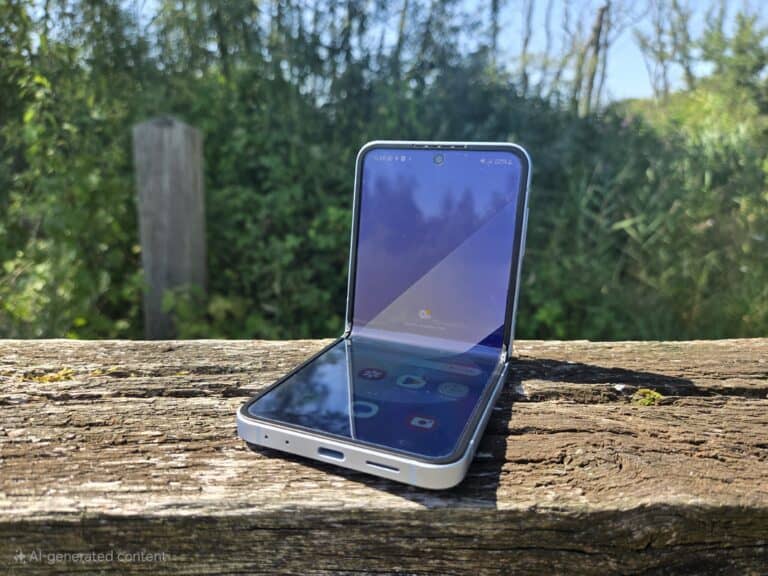Samsung has unveiled its sixth generation of foldable phones. The Samsung Galaxy Z Flip 6, while more compact than its sibling, the Galaxy Z Fold 6, doesn’t compromise on performance. Despite a few minor drawbacks, the new Flip presents itself as a compelling alternative to conventional smartphones.
The Z Flip 6’s design remains largely unchanged from its predecessor. The main screen retains its FullHD+ resolution, which translates to an elongated 1080p display with a 22:9 aspect ratio. When folded, only the cover screen is visible, featuring a resolution of 720×748 pixels and a pixel density of 306 PPI. Like the Z Flip 5, Samsung’s latest model remains relatively light at 187 grams. A new matte aluminum finish has been introduced, which effectively minimizes visible fingerprints on the device’s edges. The rounded contours of the Z Flip 6 echo the design language of the regular S24 series, while its larger counterpart, the Galaxy Z Fold 6 (which we’ll review separately), adopts styling cues from the Ultra series.
Also read: First impressions: Samsung Galaxy Z Flip 6, Z Fold 6 follow familiar recipe
Smartwatch in your pants
The cover screen, a defining feature of the Z Flip series, has steadily grown in size over the years. However, this year marks a departure from that trend, as the Z Flip 6’s cover screen maintains the same dimensions as its predecessor, the Z Flip 5. While the display doesn’t intrude upon the space occupied by the two main cameras, it does grab a little bit of extra breathing room on their flank. This approach differs from that of the recently launched Razr 50 Ultra, where Motorola opted to expand the cover screen beyond the camera area, enveloping its two main shooters. Samsung’s more conservative approach is largely a matter of personal preference.
What’s less subjective is the practicality of using certain apps on this compact display. Samsung has both developed and approved a selection of apps specifically for use on the cover screen. Samsung Health, the Weather app and Google Maps are logical inclusions, effectively turning the device into a smartwatch-like interface in your pocket. However, more complex actions typically require unfolding the phone to access the full-sized screen. While it’s possible to plan an entire route on Maps using the cover screen, it’s far from ideal. More elaborate app interactions simply demand more screen real estate.
For users seeking expanded functionality, Samsung’s Good Lock app allows any application to run on the cover screen. It’s a byzantine approach to reach this feature, and for good reason. Running “full-fat” apps here proves to be largely impractical, as most software fails to scale down properly (or at all) in this constrained environment. It’s understandable why Samsung chooses to disable this feature by default.
Conventional when convenient
For those accustomed to traditional smartphones, the Flip series may require an adjustment period. However, it can indeed offer a familiar user experience if needed. When unfolded, the Galaxy Z Flip 6 is remarkably unremarkable. This is a commendable achievement: the crease in the center of the screen is barely noticeable during everyday use, a far cry from foldables’ early years. While the indentation is perceptible, it presents as a subtle depression rather than a sharp demarcation to divide the display.
The screen’s 22:9 aspect ratio makes it noticeably narrower compared to devices like the iPhone 15 Pro or S24 Ultra (both 19.5:9). Although most apps are designed for wider screens than the Z Flip 6 offers, they generally scale well. This elongated aspect ratio allows for more content to be visible at once in apps like LinkedIn, YouTube, and Reddit, reducing the frequency at which one has to scroll when reading content.
The folding mechanism becomes considerably smoother after its initial activation, a characteristic common to all foldable devices. Some flexibility in the hinge is to be expected. However, we observed some concerning sounds after just half a day of use, without exposure to dust or sand. Each unfolding action is accompanied by a crackling noise now, coinciding with the angle at which the internal screen wakes up. Given that Samsung promises seven years of software updates for the Z Flip 6, durability across all aspects of the device is crucial. It raises questions about how these sounds might evolve over years of use and wear.
The earlier comparisons to devices like the iPhone 15 Pro and Samsung’s own Galaxy S24 Ultra isn’t just willy-nilly. The Z Flip 6’s price point (starting at 1,199 euros) places it in the same bracket as these high-end smartphones, which is why we’ll frequently draw comparisons, particularly with the S24 Ultra. The Flip is at least 300 euros more expensive than the base model S24. For this price premium, you get 12GB of RAM instead of 8GB, matching the Ultra’s specifications. Additionally, the Z Flip 6 utilizes the Snapdragon 8 Gen 3 “for Galaxy,” the same Samsung-modified version of Qualcomm’s flagship chip found in the S24 Ultra. Sadly, Samsung reverted back to Exynos for its regular S24 series, having given us Europeans the prized Qualcomm Snapdragon 8 Gen 2 in the S23.
Geekbench 6 scores are nearly identical between the Z Flip 6 and S24 Ultra. On average, the Flip falls just shy of the Ultra’s 2301 single-core and 7238 multi-core CPU benchmarks, though this difference is imperceptible in everyday use.
Why are we drawing such explicit comparisons between these two models? Because for a similar price, consumers can choose between the folding functionality of the Z Flip 6 or the conventional powerhouse that is the S24 Ultra. It’s important to note that opting for the Flip involves trade-offs. In terms of display quality, the Ultra has a clear advantage. Its anti-reflective coating is particularly impressive and noticeably absent on other phones once you’ve experienced it. While the Z Flip 6’s screen is by no means a weakness, it’s crucial to be aware of what alternatives offer, even just within Samsung’s own lineup.
Read more: Samsung Galaxy S24 Ultra review: much more than just AI
Galaxy AI
As promised in our initial impressions of the Z Flip 6 and Z Fold 6, we’ve taken a closer look at Galaxy AI again. It has made a significantly better impression than the unofficial beta we encountered during the S24 Ultra launch. Previously, the system was overly cautious, refusing to generate AI summaries for content it deemed harmful, often to an excessive degree. Now, it employs a more reasonable definition of “harmful content.” For instance, the feature now works consistently on our own website.
The addition of the sketch-to-image feature represents a meaningful expansion of Galaxy AI, significantly enhancing image-related AI operations. The tool can make some amount of sense of even the roughest of sketches and transform them into AI-generated images with impressive results.
However, after extended use, it becomes apparent that Galaxy AI often amounts to little more than an interesting novelty. Users may find themselves actively seeking opportunities to utilize all the AI features. Chat Assist, for example, only proves useful if you struggle to stick with formal communication when appropriate. Similarly, Note Assist is as likely to mess up your notes as it is to improve their formatting.
Certainly, some AI capabilities prove to be consistently useful. Interestingly, many of these features are actually developed by Google, though they’re conveniently hiding under Samsung’s Galaxy AI umbrella. Notable examples include Circle to Search and Generative Edit, which are also available on Google Pixel phones. While these are valuable additions to the AI suite, they’re thusly not exclusive to Galaxy smartphones.
Battery life, call quality and a change of habit
The Z Flip 6 boasts a slightly larger battery than its predecessor, the Z Flip 5: 4,000mAh compared to 3,700mAh. In real-world usage, this translates to approximately 6-7 hours of screen time, typically leaving 20-30 percent battery remaining at day’s end. While insufficient for two full days of use, it should satisfy the needs of an average smartphone user. Other parties have conducted tests, such as continuous YouTube playback, yielding more impressive results of up to 9 hours. Regardless, it’s important to note that while such benchmarks are sophisticated, they don’t accurately reflect real-world usage patterns (as testers are often at pains to point out). Ultimately, one might justifiably expect better battery life from a device in this category, especially when compared to alternatives like the S24 Ultra.
You could be forgiven for forgetting all about the fact phones can let you call people. Conversations are reasonably clear on the Z Flip 6 end, but notably, its users should expect positive noises coming from the other side. Call quality for whoever you’re talking to is so good it gets mentioned through completely unprompted remarks.
Interestingly, yours truly found the Z Flip 6 influencing personal phone usage habits. The smaller cover screen, with its limited app and feature accessibility, naturally encourages brief interactions. The act of unfolding the device for more comprehensive use becomes a deliberate choice, potentially discouraging absent-minded scrolling and frequent, haphazard app-opening. In essence, it’s a product that’s subtly telling you to use it less – a characteristic that could very much be taken as a positive. However, this design also means that taking quick snapshots requires an extra step, as the main cameras are not immediately ready to fire when the device is folded.
Cameras
The Samsung Galaxy Z Flip 6 features a trio of cameras: a 10-megapixel selfie shooter, a 50MP main camera, and a 12MP ultrawide lens. Among these, the 50MP sensor stands out as the highlight, being the only camera to receive a substantial upgrade from the Z Flip 5. The night mode capability has also seen significant improvement. However, it’s worth noting that despite these enhancements, the camera system can’t hold a candle to the performance of its Ultra counterpart (as demonstrated in this video).





Samsung provides quick access to 0.6x and 1x zoom in standard photo mode, with 2x, 4x, and 10x options hidden behind an additional tap. As shown in the results above, image quality noticeably deteriorates at 4x zoom and beyond, almost appearing as if the lens were dirty, though it wasn’t. Unsurprisingly, the Galaxy S24 Ultra’s camera system remains unrivaled (which is to be expected given its four-camera setup, including a 200MP sensor). A more apt comparison is with the standard S24, which yields largely similar results as others have shown. We ourselves lack any firsthand experience with that particular Samsung model and thus can’t provide a comprehensive comparison between the S24 and Z Flip 6. Our frame of reference is a fortnight with the S24 Ultra earlier in the year, which set a high benchmark.
Conclusion: a smart step forward
One shouldn’t expect miracles from the Z Flip 6. Despite its price, it’s not positioned as the flagship model. After six generations of foldable phones, Samsung has clearly recognized this as a niche market, much like their ruggedized XCover series designed for those requiring extra-durable smartphones.
Nevertheless, the Flip series has certain expectations to meet. Given its price point exceeding a thousand euros, competent cameras and high-end construction are non-negotiable features. The hinge remains inherently delicate and potentially noisy, while previous Flip models suffered from problematic screen cracks, dents and general material deterioration. Are these the unfixable flaws for foldables? It may be so.
Regardless, the Samsung Galaxy Z Flip 6 emerges as a solid all-rounder with a unique selling point. Those who appreciate smartwatch functionality but are reluctant to buy or wear one may find significant value in the cover screen. Additionally, the folding mechanism discourages prolonged scrolling through feeds by requiring an extra action, which some may find beneficial for reducing distractions. The capable cameras, powerful processor, Galaxy AI integration, and the familiar OneUI make the Z Flip 6 a comprehensive package. While it may not be the ultimate all-rounder like the S24 Ultra, that offering might be too large, too bulky, or simply too conventional for some.
Also read: Review: HP E45c G5 vs. Philips 49B2U6900CH monitors – bigger vs. biggest


